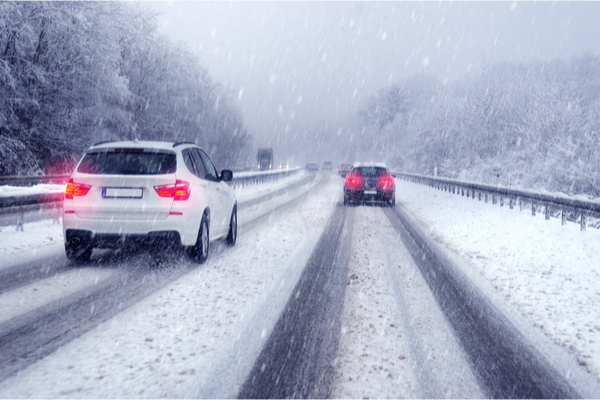It’s that time of year when temperatures drop to near or below the freezing mark, and snow becomes more frequent across the U.S. On average, weather-related vehicle crashes kill more than 6,200 people and injure more than 480,000 per year across the nation. To make sure you get to your destination safely, here are some winter driving safety tips, courtesy AAA and the National Weather Service (NWS):
Driving in the Cold Weather
- Keep a winter weather safety kit in your car. This should include extra food and water, warm clothing, a flashlight, a glass scraper, blankets and medications.
- Make sure your tires are properly inflated and have plenty of tread.
- Always keep at least half of tank of fuel in your vehicle. Condensation can sometimes form in the empty areas of a gas tank. In winter, it is possible for this condensation to freeze inside the gas lines.
- Do not warm up a vehicle in an enclosed area, such as a garage. This will trap carbon monoxide in the enclosed area, which will then seep into the vehicle.
- Do not use cruise control when driving on slippery surfaces, such as ice and snow.
Driving in the Snow
- Drive slowly. Always adjust your speed down to account for road conditions when driving on snow or ice.
- Accelerate and brake slowly. Apply the gas slowly to regain traction and avoid skids. Don’t try to get moving in a hurry and take extra time to slow down when stopping.
- When there are hazardous road conditions, only go out if necessary.
- Increase your following distance. By increasing your following distance by 5 or 6 seconds, the longer distance will provide an increased margin of safety to stop.
- Know your brakes. Whether or not you have anti-lock brakes, keep the heel of your foot on the floor and use the ball of your foot to apply form, steady pressure on the brake pedal.
- Don’t power up or stop going up a hill. Applying extra gas on snow-covered roads will just make your wheels spin. There’s also nothing worse than trying to get moving up a hill on an icy road. When approaching a hill, get some inertia going on a flat roadway and then keep a steady speed as you go up the hill. As you reach the crest of the hill, reduce your speed, and proceed downhill slowly.
- If you do start to slide on ice, turn the steering wheel in the same direction that the back wheels are moving. Although somewhat counterintuitive, this will force the front of the car to turn in that direction, reversing the direction of the skid on the car’s rear.
Driving Long-Distance Winter Trips
- Be prepared by having your vehicle checked before hitting the road.
- Check the weather along your route and when possible, delay your trip if bad weather is expected.
- Stay connected by notifying others about your route, destination and estimated time of arrival before leaving.
- If you get stuck in the snow, stay with your vehicle as it provides temporary shelter and makes it easier for rescuers to locate you. Don’t overexert yourself if you are digging out your vehicle. Be visible, such as tying a brightly colored cloth to the antenna of your vehicle or place a cloth at the top of a rolled up window to signal distress. At night, keep the dome light on if possible. Clear the exhaust pipe so it is not clogged with snow, ice or mud. A blocked exhaust pipe can cause deadly carbon monoxide to leak into the passenger compartment of the vehicle while the engine is running. Stay warm by using whatever is available to insulate you body from the cold. This could include floor mats, newspapers or paper maps. Lastly, conserve fuel, if possible. Only run the engine and heater long enough to remove the chill.
Additional Tips
- If the temperature outside is near freezing, it is safest to assume ice is present on roadways.
- With nothing but cold air underneath them, wet bridges and overpasses freeze before solid ground, and are more likely to be icy.
- If there is ice on power lines or tree branches, the weight may cause them to snap and fall. Avoid driving during those conditions if possible. Never touch a downed power line and call 911 if you encounter one.
- Be alert for snowplows and allow plenty of room for them to pass. If you are going around a plow, only do so when you can see the road ahead of the plow.
The weather is unpredictable but preparing ahead of time can help you make sure you get to your next destination safely.
—
Photo Credit: Petair / Shutterstock.com
